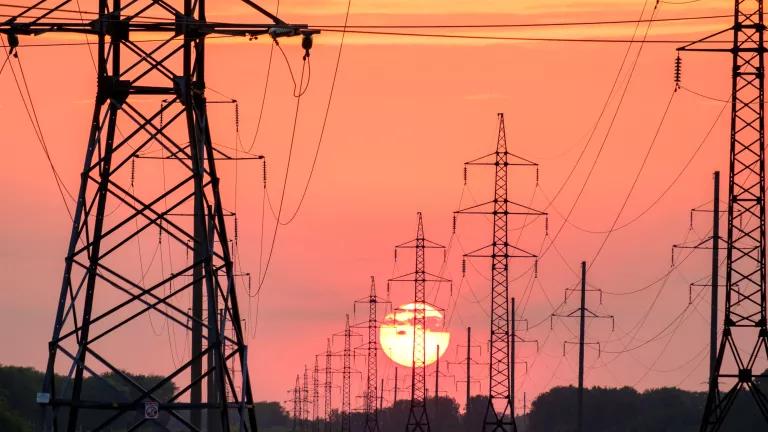On Wednesday California will launch the world’s second-largest carbon market, putting in place a key strategy to achieve the goals of California’s landmark clean energy law, AB 32. More than five years in the making, California’s cap-and-trade program will for the first time hold the state’s largest emitters accountable for their carbon pollution, while providing incentives to go beyond the minimum and compete to deploy innovative clean energy solutions.
For the eighth-largest economy in the world, that is no small feat.
Predictably, the petroleum industry and other opponents of California’s drive towards clean energy continue to push Governor Brown to reverse course. Their calls for delay and 11th hour giveaways are the same roadblocks they pushed for in the Legislature, at the state's Air Resources Board and with California voters — who spectacularly turned them away by rejecting Prop 23 in 2010, and just last week reaffirmed their commitment to accelerating clean energy and energy efficiency by passing Prop 39.
Fortunately, for the overwhelming majority of Californians who have voted time and again in support of clean air and polluter accountability, all signs point to the first auction proceeding as planned. By moving forward with implementing AB 32, California is not only making good on promises to improve air quality and hold polluters accountable, it is ensuring the state retains its place as a global clean energy powerhouse.
Carbon Auction Nuts and Bolts
Under California’s cap-and-trade program, power plants, refineries and other large polluters must surrender pollution credits, known as “allowances,” equal to their reported and verified emissions. As the number of available allowances declines over time, so too must statewide emissions – ensuring California achieves AB 32’s mandate to cut carbon pollution back to 1990 levels by 2020 (see here for more on the interaction between the cap and other pollution reduction programs under California’s AB 32 Scoping Plan).
Each facility has two basic options to comply: reduce the emissions associated with its own operation, thereby mitigating the number of allowances it needs to acquire and hand in, or purchase allowances on the market. Facilities can buy and sell allowances from each other – the ‘trade’ component of cap-and-trade – or purchase them at auction.
On Wednesday morning, the California Air Resources Board will open the bidding window for the first batch of allowances put up for auction – in effect, hitting ‘launch’ on one of California’s most significant and pioneering climate and clean energy initiatives.
Here’s a rundown of how the auction will work on Wednesday (check back on Monday, November 19, when auction results are made public, for a follow-up piece on what happened and what it means for climate policy in and outside California):
- Two types of allowances will be offered for sale on Wednesday: ‘vintage 2013’ allowances, which can be used by businesses to offset their emissions starting next year, and ‘vintage 2015’ allowances, which can be ‘banked’ for later use but cannot be used for compliance until 2015 (in cap-and-trade parlance, ‘borrowing’ is not allowed). Introducing some 2015 allowances early provides businesses the opportunity to plan for future compliance and will help bolster an active trading market.
- Roughly 23 million allowances will be offered for sale from the 2013 batch, just under 40 million from the 2015 batch. Proceeds from the sale of 2013 allowances will be returned to the state’s electric utilities, who by law must use it for the exclusive benefit of their customers, including providing direct rebates or providing new opportunities for residences and businesses to benefit from improved energy efficiency. In the ten Northeast states that participate in a cap-and-trade program to control carbon pollution from power plants (known as the Regional Greenhouse Gas Initiative, or RGGI), auction proceeds have already generated more than $1 billion in energy savings for customers by financing increased investments in efficiency and contributed $1.6 billion to economic growth in the region.
- The proceeds from the sale of 2015 allowances will flow into a special fund in the state treasury (which will also receive the proceeds of industrial-sector allowances designated for auction starting next year). Under the terms of AB 1532 and SB 535, which Governor Brown signed in September, CARB will develop investment plans with the Department of Finance to capitalize on opportunities to drive emission reductions and spur new economic growth in clean transportation, smart growth, energy efficiency and other sectors that maximize returns for the California economy. SB 535 further ensures that at least 10 percent of those projects are located in the state’s most disadvantaged communities, and 25 percent of all proceeds benefit those communities.
- To place a bid, every participant must first register with CARB and sign up for a compliance account in CARB’s central database, which will track every allowance transaction (including in the secondary market). Each participant is subject to a purchase limit to prevent hoarding or an attempt to corner the market, while the minimum bid CARB will accept is 1000 allowances. An independent market monitor will keep an eye on the whole picture, and report any suspicious activity to CARB.
- Building on lessons learned from other cap-and-trade programs, CARB will not accept bids for allowances below $10 (the ‘floor price’). The floor price, which rises 5% per year plus inflation, is designed to provide businesses and investors an added measure of certainty on what to plan for as they look for ways to cut emissions, and provide a stable price signal to drive further clean energy investment into California (the state already captures more cleantech venture capital every year than the rest of North America combined, and leads the nation in clean energy jobs and businesses).
- Following the initial auction on Wednesday, CARB will hold auctions every quarter. Any allowances unsold will roll over to subsequent auctions. The first due date for businesses to turn in allowances to match their emissions comes in November 2014.
On the surface, Wednesday’s auction will involve little by way of fanfare. At 10 a.m. PST the bidding window will open, electronic bids will be transmitted and collected, at 1 p.m. PST the bidding window will close (winners will be notified via email).
But the significance of the event tells a different story. On Wednesday morning, California will embark on a new chapter of its storied climate and energy leadership, the moment when a central component of its comprehensive plan to reduce carbon pollution and advance clean energy solutions officially takes flight.
Here’s to a big step towards a clean energy future in California.



